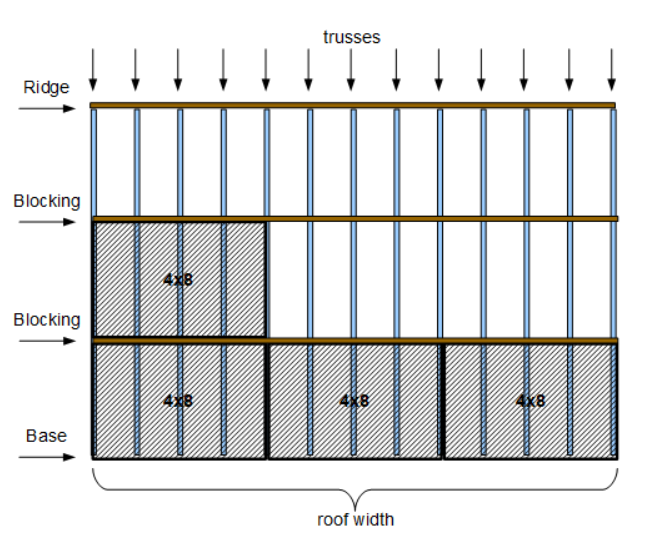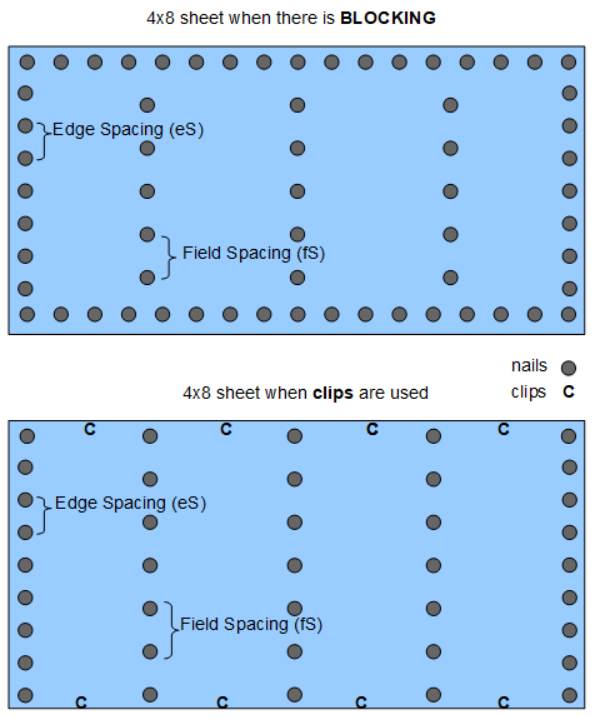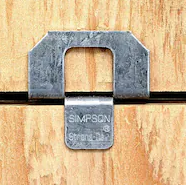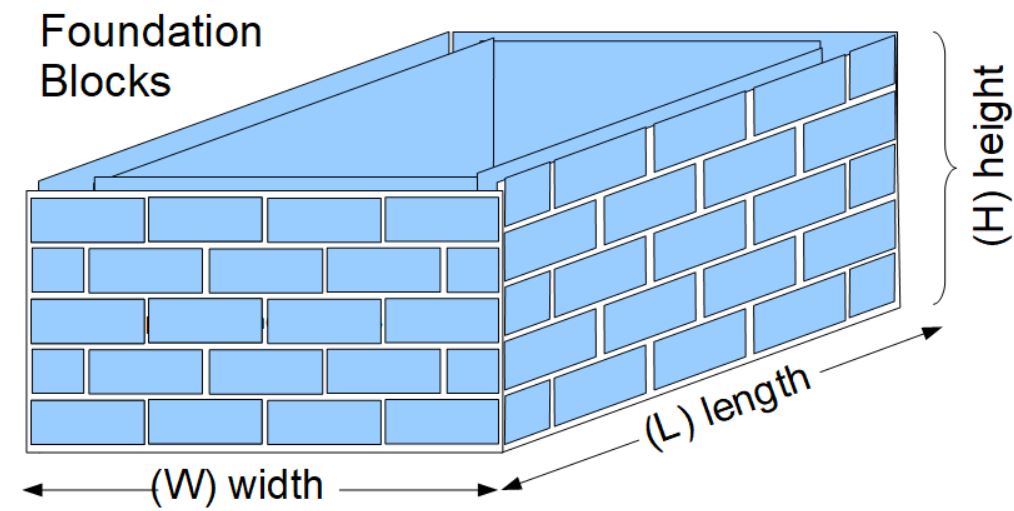House Sheathing
Tags | |
UUID | deabeccb-f36f-11ee-9b96-bc764e203090 |
The House Sheathing calculator computes the number of 4x8 sheets (e.g., OSB or T1-11) needed for a basic structure with gable ends.
INSTRUCTIONS: Choose units and enter the following:
- (H) Height Below Gable
- (S) Span of Building
- (L) Length of Building
- (P) Pitch of Roof
Sheathing (nS): The calculator returns the number of 4x8 sheets needed to cover the outer wall surface area. The surface area is also returned in square feet. However, this can be automatically converted to compatible units via the pull-down menu.
The Math / Science
The House Sheathing equation computes the surface area of the walls of a building with gable ends and uses that to estimate the number of 4x8 sheets are required to cover it. It is useful in computing the amount of materials for outer wall like OSB or plywood under siding, or finished pressure treated boards like T1-11 panels.
Plywood and OSB Price Survey Information
The following is web survey of 4x8 sheets of plywood and OSB. It provides the date of the web survey, the store and several price points on items that were advertised on the store's website. This is for convenience only. Local pricing should ALWAYS be used!
- Survey Date: 4/26/24
- Survey Store: Menards
- Price of 4x8 3/4" Plywood: $35.55 USD
- Price of 4x8 5/8" Plywood: $30.78 USD
- Price of 4x8 1/2" Plywood: $28.95 USD
- Price of 4x8 3/8" Plywood: $24.03 USD
- Price of 4x8 3/4" OSB: $30.49 USD
- Price of 4x8 5/8" OSB: $23.87 USD
- Price of 4x8 1/2" OSB: $22.45 USD
- Price of 4x8 1/4" OSB: $18.98 USD
- Price of 4x8 3/4" Pressure Treated Plywood: $50.98 USD
- Price of 4x8 1/2" Pressure Treated Plywood: $44.84 USD
- Price of 4x8 5/8" Grooved Panel Siding: $53.39 USD
- Price of 4x8 1/2" Grooved Panel Siding: $48.99 USD
NOTE 2: Some stores carry plywood and OSB with thicknesses 1/32nd smaller than others. Therefore, 3/4" might be represented by 23/32", 5/8" by 19/32", 1/2" by 15/32", and 3/8" by 11/32".
CAUTION: The pricing information provided is for calculating convenience with NO implied guarantees to the accuracy of the values listed. Authoritative sources should be sought to confirm any value before risking health or wealth on the veracity of the data. Furthermore, Calc gives no guarantee that you will be able to buy products at listed prices or even if they will be available. The data provided is purely a convenience for making estimates, so we strongly recommend that one ALWAYS use local pricing and authoritative specifications.
The Pricing Data can be used for the Subflooring Material Cost Calculator, CLICK HERE or in the Cost of Plywood Calculator,CLICK HERE.
4x8 sheets on Framing
Using the dimensions of the framing to compute the area. Then compute the number of 4x8 sheets required to cover the framing. Modern construction techniques take advantage of the time saving achieved through using pneumatic nail guns. Nail guns are used to rapidly nail sheeting to roof trusses and walls saving time and money.

Blocking or Clips
The number of nails that will be needed are determined by the pattern of nails. There are two different patterns for nails based on whether there is blocking that allows continuous edges or if clips (see picture) are used. The diagram shows the two patterns.


Simple Building Calculator
Functions to estimate material amounts for a stick-built building from the bottom (footers and foundation) up through framing, siding and roofing. This is useful for a cabin, tiny-house or even a backyard shed. The functions include the following:
Summary Function
- Building or Shed Materials: Computes the top (roof) to bottom (deck) framing and roofing materials needed for a simple building based on a few dimension.
Roofing Functions:
- Gable Roof Area: Computes the total surface area of a roof, the number of 4x8s, the number of bundles of shingles and the number of roofing nails needed for a roof based on the length, span, pitch and overhang.
- Trusses Needed for Roof: Computes the number of trusses needed for a roof based on the ridge length and truss spacing.
- Rafters for Gable Roof: Computes the total number and length of rafter boards (roof joists) for a gabled roof based on the ridge length, pitch and span. It also returns the length of the ridge board, and the length and number of rafter ties and collar ties.
- Purlins for Gable Roof: Computes the total number and length of purlins for a simple gable roof based on the ridge length of the roof, the roof pitch and the span of the roof.
- 4x8 Sheathing for Gable Roof: Computes the total surface area of a roof, the number of 4x8s and framing nails needed for a gabled roof based on the length, span, pitch and overhang.
Siding Functions:
- Siding for Rectangular Wall: Computes the siding materials for a rectangular wall (squared corners) for horizontal panels or boards based on the dimensions of the wall and the panels or boards.
- Siding for Gable End: Computes the siding materials (horizontal panels or boards) for a wall under a gable roof end, based on the dimensions of the wall and the panels or boards.
- Metal Siding for Gable Ends: Computes the number of vertical panels for a wall under a gable roofline. It also returns the total area of gable end wall, number of screws needed and the cut angle of the panels.
Framing Functions:
- Plate Boards for Room: Computes the number of top and bottom plate boards, above and below the studs, required for a room based on the length of the four walls and whether the top plate is doubled or single.
- Studs for a Room: Computes the number of stud boards required to frame a room based on the length of the four walls, including extra studs at the corners where the walls meet.
- Drywall for a Room: Computes the number of drywall sheets (4x8 or 4x12) required to cover a walls and ceiling of a rectangular room based on the length and height of the walls.
- Drywall for Wall: Computes the number of drywall sheets (4x8 or 4x12) required to cover a wall based on the length and height of the wall.
- House Sheathing: Computes the number of 4x8 sheets (e.g., OSB or T1-11) needed to cover the exterior walls of a basic structure with gable ends. For more siding options, see the Siding Calc.
- House Wrap: Computes the square feet of house wrap needed for a basic structure with gable ends.
- Subfloor 4x8 Sheets: Computes the number of 4x8 sheets (e.g., plywood or OSB) required for a floor, sub-floor or deck.
- Floor Joist Count: Computes the number and length of joists (joists and end plates) required for a floor or deck based on the dimension of the room or deck and the on-center joist separation. It also includes the number of joist hangers.
- Foundation Sill Plates: Computes the number of sill plate boards to connect a foundation to the first deck.
Foundation and Basement Functions:
- Concrete in a Slab: This computes the volume of concrete needed for a slab. The volume is returned in cubic yard and equivalent amount by number of bags (40lb, 60lb, 80lb). It also return the area of the slab and the length of forms that might be needed.
- Blocks for Foundation:
 This computes the number of blocks needed for a foundation based on the foundation dimensions and the size of the blocks.
This computes the number of blocks needed for a foundation based on the foundation dimensions and the size of the blocks. - Concrete Needed for Foundation: This computes the amount of concrete needed in a poured concrete foundation based on the dimensions of the foundation. It also returns the square feet and number of 4x8s needed for the forms.
- Concrete for Footers: This computes the amount of concrete needed in a footer based on the dimensions of the footer.
Equations and Data Items
Collections
- Comments
- Attachments
- Stats
No comments |

